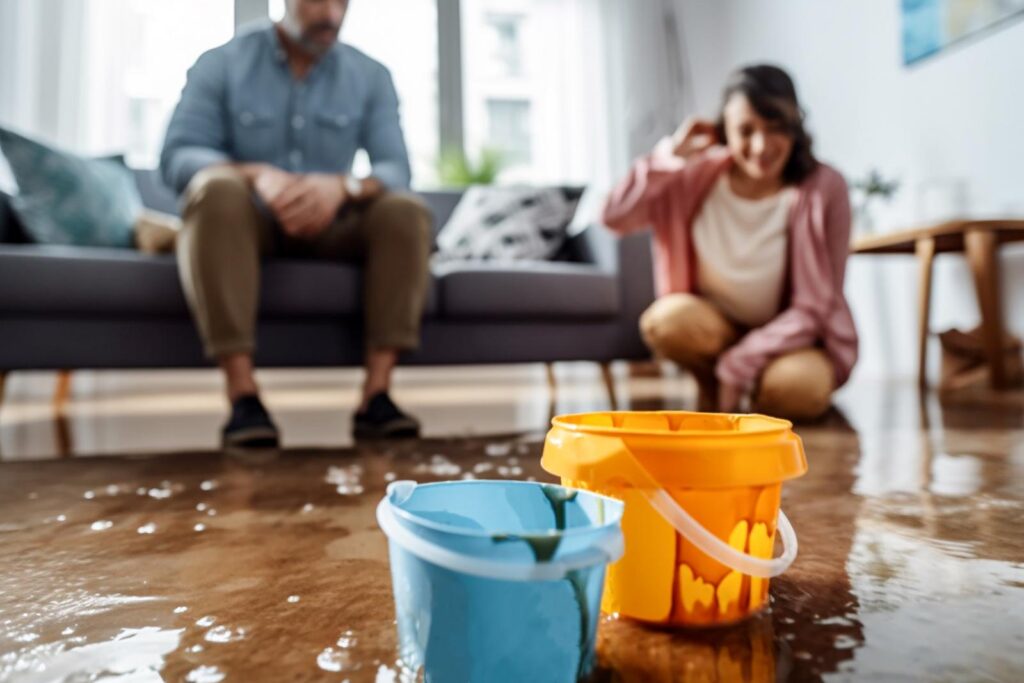
Contents
When faced with the aftermath of a flood, it’s essential to approach the flood cleanup and restoration process methodically. Start by evaluating the extent of the water damage and any safety risks present. You’ll need to act quickly to extract the water effectively. As you navigate this challenging situation, understanding the right techniques can make all the difference in restoring your home to its former state. Let’s explore the key strategies you need to take into account.
Key Takeaways
- Assess water damage and safety risks before cleanup; ensure structural integrity and check electrical systems to prevent hazards.
- Use appropriate extraction methods, starting with a sump pump for heavy flooding, followed by wet/dry vacuums for thorough removal.
- Implement effective drying techniques using high-velocity fans and commercial dehumidifiers to eliminate moisture and prevent mold growth.
- Conduct regular inspections for mold and maintain indoor humidity below 60% to inhibit its development and spread.
- Document damage for insurance claims, replace affected materials, and consider aesthetic improvements during restoration for a comfortable environment.
Assessing Water Damage and Safety Risks
When you’re faced with the aftermath of a flood, it’s crucial to assess the water damage and safety risks before diving into cleanup.
Start by evaluating the extent of the water damage in your home. Look for signs of structural issues, like sagging ceilings or warped floors, which could pose risks. Don’t forget to check your electrical systems—turn off the power if you see any water near outlets or appliances.
Next, conduct a safety evaluation for yourself and your loved ones. Wear protective gear, including boots and gloves, to shield against contaminants.
Be mindful of sharp objects or debris lurking beneath the water. It’s okay to feel overwhelmed; remember, you’re not alone in this.
Reach out for support from friends, family, or local organizations. Taking these initial steps helps promote a safer and more effective cleanup, paving the way for healing and restoration in your community.
Effective Water Extraction Techniques
As you begin the water extraction process, it’s essential to act quickly to minimize damage and prevent mold growth.
Start by evaluating the water level and determining the best approach. If the flooding is severe, a sump pump can be your best ally. It efficiently removes standing water, making your space safer and more manageable.
Once you’ve tackled the bulk of the water, switch to vacuum extraction methods to address the remaining moisture.
Use a wet/dry vacuum to pull out water from carpets and floors. Be thorough; this step is critical in preventing long-term damage.
Drying and Dehumidification Processes
To effectively restore your space after a flood, drying and dehumidification are essential steps that can’t be overlooked.
Start by selecting the right drying equipment; high-velocity fans and air movers can considerably speed up the evaporation process. Position them strategically to guarantee ideal airflow across wet surfaces.
Next, focus on dehumidifier selection. Opt for a commercial-grade dehumidifier designed for large areas, as it’ll efficiently extract moisture from the air. Monitor humidity levels regularly to determine when conditions are right for your space to return to normal.
As you progress, remember that thorough drying is critical to guarantee a safe and comfortable environment.
This process not only helps in restoring your home but also brings peace of mind, knowing you’re taking proactive steps to reclaim your space.
You’re not alone in this; every effort you make is a step toward recovery and belonging.
Mold Prevention and Remediation Strategies
Even after successfully drying out your space, the risk of mold growth remains a pressing concern.
To protect your home and loved ones, you need to adopt effective mold prevention and remediation strategies. Here’s how you can tackle it:
- Inspect Regularly: Check for any signs of moisture or dampness in hidden areas like basements or behind walls.
- Control Humidity: Keep indoor humidity below 60% using dehumidifiers and proper ventilation.
- Use Mold-Resistant Products: When repairing, consider mold-resistant paints and materials to inhibit growth.
- Act Quickly: If you spot mold, address it immediately using appropriate remediation methods, such as scrubbing with detergent or seeking professional help.
Repairing and Restoring Your Home After Flooding
Once the floodwaters recede, the formidable task of repairing and restoring your home begins.
First, assess the damage thoroughly, documenting everything for your flood insurance claim. This step is essential as it helps you secure the funds you need to rebuild. Don’t hesitate to lean on homeowner resources, like local recovery programs or online guides, which can provide invaluable support during this challenging time.
Next, focus on addressing structural issues. Check for damage to the foundation, walls, and flooring, as these can lead to bigger problems down the line.
After that, replace any damaged drywall and insulation to prevent mold growth.
Finally, consider your home’s aesthetic. Choose colors and designs that bring you comfort and joy, creating a space that feels like home once again.
Recap
In the aftermath of a flood, remember that timely action is essential. Did you know that homes that are not dried within 24-48 hours have a 50% higher chance of developing mold? By following effective cleanup and restoration strategies, you can greatly reduce health risks and restore your home’s integrity. Don’t hesitate to seek help and utilize community resources; your safety and well-being are paramount as you navigate this challenging journey toward recovery.
Recent Posts
Essential Mold Prevention Tips Post-Flooding
Imagine standing in a damp, musty room, where the remnants of floodwater linger and the
10 Essential Tips for Effective Flood Recovery
It’s often said that effective flood recovery hinges on a structured approach, but how can
7 Best Flood Cleanup and Restoration Solutions
Imagine standing in a room where the walls glisten with water, remnants of a flood
